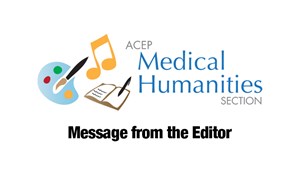
From the Chair
Seth C. Hawkins MD, FACEP
Since the beginning of my tenure as chair of the ACEP Medical Humanities Section, we have been focusing on ways the medical humanities are clinically relevant. As discussed in prior installments of this column, too often the medical humanities are relegated to a “hobby” or “wellness” category. While these are important manifestations of our activities, I hope we can all agree that the lessons and frameworks of the medical humanities play a critically important role in bedside, immediate clinical care as well.
One key element to that is the role of narrativity. Narrative medicine has been growing in prominence recently—indeed, multiple universities now offer master’s degrees in this discipline. Narrativity weaves its way through all elements of medical care and is a crucial clinical skill for emergency medicine practitioners. Few other medical specialties task the practitioner with learning someone’s “story,” analyzing it, acting on it, and moving the patient to the next stage of their story without expectation of revisiting their case. We build completed stories multiple times every hour of our shifts; or, perhaps more honestly, we participate in stories as fully as possible, and accept the uncertainty we have of rarely having access to as much of the story as we’d like.
Even our clinical tools engage narrativity as cores to medical decision-making. Take the HEART score, for example. Age and risk factors are fixed characteristics that will not change. Their contribution to analyzing the presence of an acute coronary syndrome does are merely supportive—they will be the same whether the patient presents with an ankle injury or an actual NSTEMI. HEART scores are most often helpful when troponin is normal or equivocal (the disposition of an NSTEMI doesn’t require a decision tree) rendering troponin rarely helpful. The key inflection point is the difference between 3 and 4 in this scoring system, and while fixed characteristics provide a baseline scaffolding, it is often the “suspiciousness” of the history that makes the difference between a discharge score and an observation/admission score. This is the power of narrativity, which even in formal scoring systems carries massive importance.
This suggests that training sensitivity to and skills in eliciting and analyzing narratives should be core to medical training and practice. While this is often implicit in both, we as medical humanities specialists and supporters should be working to make those manifestations explicit. Master’s degrees in this specialty are one potential step; formal divisions and training programs in medical schools and residencies are another. Ultimately, calling out the role of narrativity (and potentially ethnography, from a different training framework) in the work we do as often as possible may be the most important first step to recognizing the prominence of this facet of our work, and the attention it deserves.
We’d very much like for this Section to be a part of that process, and we welcome any ways it can better achieve this goal, and other goals involving the fostering and application of the medical humanities. Please consider how you might contribute to this effort!
Note that we do have a position open for a newsletter editor. We thank Pete Paganussi for his many excellent years of service! Please consider whether that’s your niche—we’d love to talk to you if it could be.
After holding our section meetings virtually since 2020, we do plan to hold an in-person meeting at ACEP23 in Philadelphia. Note that you can register early and receive a $100 discount! Use the code ULTRAEARLY.
One last item of business: our section voted to allow non-member section subscriptions. For background information, the ACEP Board voted to permit non-members to participate in sections in response to inquiries over the years from members and leaders of several sections about allowing non-ACEP members to participate in sections as non-voting members. Members of these sections interact and work closely with respected partners, such as nurses, PAs and EMTs, etc, who cannot join ACEP, but provide value to section discussions and work products. These non-ACEP members often hold key roles and positions that can be influential in developing policies, guidelines and other clinical and practice resources.
Current interpretation of ACEP Bylaws limits section membership to only ACEP members, and the Board decided to allow the Section Subscription option to encourage more robust participation in the ACEP sections of membership.
Several years ago, section newsletter subscriptions were available to non-members but had limited participation, partly because of the narrow scope of benefit of receiving just a newsletter. The new Section Subscription package includes the e-newsletter and access to the section web site and its e-list for a $50 annual fee. Please encourage your non-ACEP-member friends to join our section!




